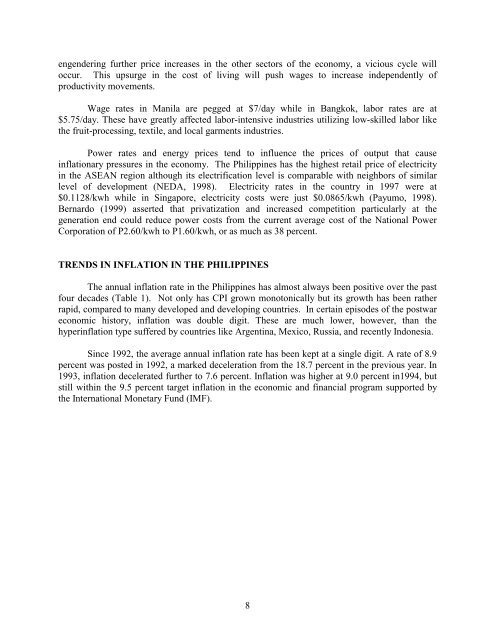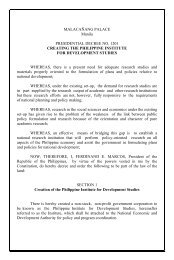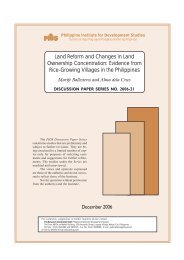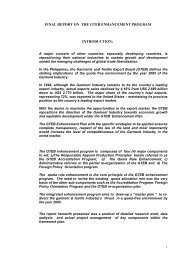price stabilization measures and its effects on - Philippine Institute ...
price stabilization measures and its effects on - Philippine Institute ...
price stabilization measures and its effects on - Philippine Institute ...
Create successful ePaper yourself
Turn your PDF publications into a flip-book with our unique Google optimized e-Paper software.
engendering further <str<strong>on</strong>g>price</str<strong>on</strong>g> increases in the other sectors of the ec<strong>on</strong>omy, a vicious cycle willoccur. This upsurge in the cost of living will push wages to increase independently ofproductivity movements.Wage rates in Manila are pegged at $7/day while in Bangkok, labor rates are at$5.75/day. These have greatly affected labor-intensive industries utilizing low-skilled labor likethe fruit-processing, textile, <str<strong>on</strong>g>and</str<strong>on</strong>g> local garments industries.Power rates <str<strong>on</strong>g>and</str<strong>on</strong>g> energy <str<strong>on</strong>g>price</str<strong>on</strong>g>s tend to influence the <str<strong>on</strong>g>price</str<strong>on</strong>g>s of output that causeinflati<strong>on</strong>ary pressures in the ec<strong>on</strong>omy. The <strong>Philippine</strong>s has the highest retail <str<strong>on</strong>g>price</str<strong>on</strong>g> of electricityin the ASEAN regi<strong>on</strong> although <str<strong>on</strong>g>its</str<strong>on</strong>g> electrificati<strong>on</strong> level is comparable with neighbors of similarlevel of development (NEDA, 1998). Electricity rates in the country in 1997 were at$0.1128/kwh while in Singapore, electricity costs were just $0.0865/kwh (Payumo, 1998).Bernardo (1999) asserted that privatizati<strong>on</strong> <str<strong>on</strong>g>and</str<strong>on</strong>g> increased competiti<strong>on</strong> particularly at thegenerati<strong>on</strong> end could reduce power costs from the current average cost of the Nati<strong>on</strong>al PowerCorporati<strong>on</strong> of P2.60/kwh to P1.60/kwh, or as much as 38 percent.TRENDS IN INFLATION IN THE PHILIPPINESThe annual inflati<strong>on</strong> rate in the <strong>Philippine</strong>s has almost always been positive over the pastfour decades (Table 1). Not <strong>on</strong>ly has CPI grown m<strong>on</strong>ot<strong>on</strong>ically but <str<strong>on</strong>g>its</str<strong>on</strong>g> growth has been ratherrapid, compared to many developed <str<strong>on</strong>g>and</str<strong>on</strong>g> developing countries. In certain episodes of the postwarec<strong>on</strong>omic history, inflati<strong>on</strong> was double digit. These are much lower, however, than thehyperinflati<strong>on</strong> type suffered by countries like Argentina, Mexico, Russia, <str<strong>on</strong>g>and</str<strong>on</strong>g> recently Ind<strong>on</strong>esia.Since 1992, the average annual inflati<strong>on</strong> rate has been kept at a single digit. A rate of 8.9percent was posted in 1992, a marked decelerati<strong>on</strong> from the 18.7 percent in the previous year. In1993, inflati<strong>on</strong> decelerated further to 7.6 percent. Inflati<strong>on</strong> was higher at 9.0 percent in1994, butstill within the 9.5 percent target inflati<strong>on</strong> in the ec<strong>on</strong>omic <str<strong>on</strong>g>and</str<strong>on</strong>g> financial program supported bythe Internati<strong>on</strong>al M<strong>on</strong>etary Fund (IMF).8









